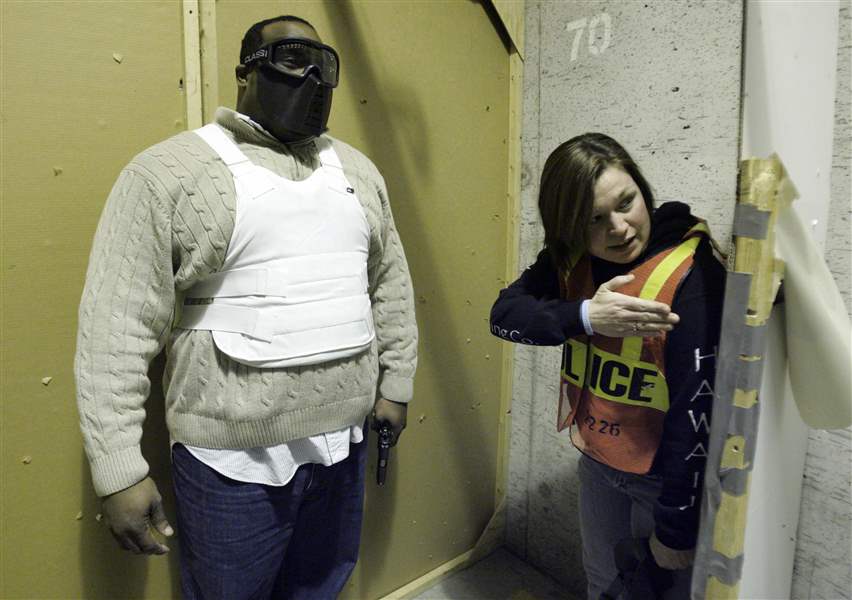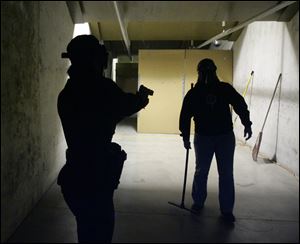
Public offered a chance to walk in officers' shoes
3/1/2010
Keith Jordan, a member of the Police Civil Internal Review Board, listens to Officer Danielle Kasprzak's analysis of his performance in an exercise at the training session.
The Blade/Andy Morrison
Buy This Image

A participant in a training exercise draws a gun on a role-playing police officer. A group of 14 people from the local media and community groups took part in the one-day session.
Imagine, for a moment, that you are the one with the badge.
The report is of an armed man in a local park, and your gun is drawn as you step out of the police cruiser. You see the man sitting on a bench, staring at the ground with a gun to his head.
But then, he looks up. Now, he's pointing the gun at you. Do you fire? Are you shot?
This is Decision Alley, the final real-life police scenario in a program that invites the public to face the sort of conflict and violence that Toledo Police must accept as part of their job descriptions.
As the community continues to grapple with last year's unusually high number of officer-involved shootings, Toledo police are offering a closer look at how officers are trained to make split-second decisions about armed suspects.

Keith Jordan, a member of the Police Civil Internal Review Board, listens to Officer Danielle Kasprzak's analysis of his performance in an exercise at the training session.
In one of the first scenarios at a recent public session that Toledo Police believe is unique in the country, Sgt. Mike Gilmore coached participants on avoiding being shot. That meant standing in front of a human silhouette and becoming the target of a revolver that spit hollow bullets tipped with balls of neon-green paint.
Sergeant Gilmore, who designed the public training sessions, trains police to simultaneously duck and dash sideways out of the line of fire.
Dodging bullets isn't easy. Lucas County Prosecutor Julia Bates has the bruises to prove it.
"It was extremely hard, and it was extremely emotional," Mrs. Bates said of the experience. "We certainly ask them [police] to do superhuman and heroic deeds, and when regular, mortal people try to do the same deeds, we fall flat on our faces."
It has been 10 years since Toledo police first invited the public to participate in these sorts of scenarios designed for police training - an invitation extended after police shot and killed four suspects in 1999.
Mrs. Bates participated in 2000, and said that, in light of the five fatal officer-involved shootings last year, she recommended that police hold the latest sessions. About 65 people are expected to participate in four sessions scheduled through March 12.
"I thought we should take a tragedy and turn it into a learning experience," Ms. Bates said.
In the most recent session Friday at the police department's Scott Park District Station, Sergeant Gil-
more challenged WTOL-TV reporter Lisa Rantala to a classroom exercise involving an armed suspect at a traffic stop.
The sergeant played the suspect, sitting with a gun in one of his raised, flailing hands and shouting: "My lover left me, don't shoot me." The reporter played the officer, standing behind with weapon drawn.
While some in the class chuckled at his theatrics, Sergeant Gilmore asked how far the armed suspect should be allowed to turn to face the officer before she should shoot. A quarter turn? A full turn?
He continued shouting as he swung around and pulled the trigger in one startlingly swift movement.
"I just shot you," he said to the reporter.
"Dang it," she said.
A real-life confrontation with an armed suspect could play out just as quickly, Sergeant Gilmore told the group of 14 at the Friday session. Participants represented The Blade and other local media, mental health agencies, a church, a mentorship program, and the prosecutor's office.
"In a split second," he said. "That's reality. That's what we face."
Sergeant Gilmore referred several times to the most recent officer-involved shooting - the Dec. 14 death of Linda Hicks, who wielded scissors as she lunged at the two police officers who confronted her in her group home.
Though the sergeant declined to discuss the case in detail, he repeatedly referred to it as "the incident with the scissors" as he noted the criticism police face after such a shooting. He said officers who face a suspect armed with a sharp object keep in mind the 21-foot rule, which says a suspect could advance 21 feet in the time it takes an officer to fire a gun.
Sergeant Gilmore is no stranger to such situations.
In March, 1992, then-Officer Gilmore and his sergeant faced an armed 19-year-old man at the former Toledo Budget Inn at Reynolds Road and Heatherdowns Boulevard.
Deon Williams was wanted on five robbery warrants and barricaded himself in a motel room when police tried to arrest him. The suspect pointed the gun at his head before turning it toward police. Officer Gilmore and another officer fired, killing him.
Although the firearms review board ruled the shooting justified, Sergeant Gil-
more endured a civil lawsuit that spent five years in the court system before it was thrown out. There were also allegations of racism: Mr. Williams was black, and the officers were white.
The experience took a toll on his family, he said. His daughter, then in fifth grade, wondered aloud about his salvation.
"She says, 'Dad, will you be able to go to heaven?' She was worried," he told the group. "I said, 'I checked with the priest. I'm good.' She worried for three years. These incidents affect not only us, but our families. So just remember that."
Sitting outside Decision Alley, the spray of gunshots becomes familiar background noise. Whether the participant took the shot or fired the weapon doesn't matter. Gunfire is the sound of mistakes being made, instructing officers said.
Keith Jordan, a member of the Police Civil Internal Review Board and vice president and director of development for the youth mentorship program, JLJ Vision Outreach, said it was difficult to confront the man with the gun in the park.
He didn't see the place to take cover from the gunfire, and said he learned that policing is a harder job than he realized. "Oh my God, he killed me. It was scary because I was going to negotiate with him," Mr. Jordan said.
"When someone has a gun to their head you think of them being in desperate situation and you want to take care of them."
Instructors weren't surprised that many participants were trigger-happy or too trusting of armed suspects.
"This is one day for you. It takes us six months in the academy," said Officer Danielle Kasprzak, who helped instruct the session. "We just hope you guys can take away from this that our job is much more complicated than just going to work every day."
Contact Bridget Tharp at:
btharp@theblade.com
or 419-724-6086.